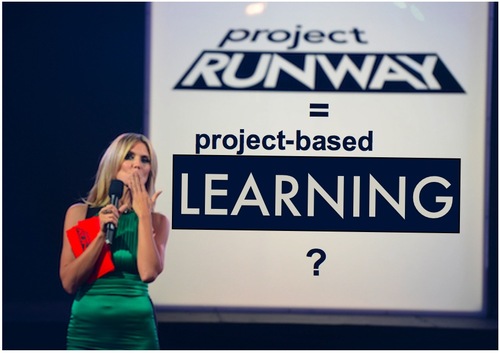Watching the latest episode of Project Runway (hey, don’t knock it ’til you’ve tried it) made me think about project-based learning and the importance of communication of grading practices.
For those who don’t know, Project Runway is Heidi Klum’s challenge-based reality show where one day you’re “in”, and the next day you’re “out” (or “Auf’d!” as we say based on the German-born host’s good-bye catchphrase). Pitting upstart fashion designers against each other, the 18-week run showcases one elimination per week, creating a sewing fight to the finish where only 1 designer can end up on top.
Normally, I end up watching the show through the lens of project-based learning and performance assessment. It’s not really much of a stretch:
- Given parameters for a task, designers make a plan (for an outfit), gather resources to execute that plan, and develop the final product of a runway-ready outfit – usually within two days or so from soup to nuts.
- The final product gets assessed by a panel of fashion professionals, who judge the outfit accoding to some specified criteria along with their own professional opinion.
- These panelists provide each “Top 3” and “Bottom 3” designer with both commendations and critical feedback. Through deliberation, they then choose one designer as the winner, and one to be Auf’d.
- Every designer who has participated – whether they continue on or not – has ideally learned more about the skills and understanding it takes to make it in this business.
This panelist interaction highlights for me the distinctions between tests and assessments, between feedback and grades. These terms get thrown around and conflated in education all the time – I thought maybe that applying them to this show would be a helpful way to distinguish them. Here’s how the analogy works for me:
- Test = The task given to the designers
- Assessment = Observation of the products that resulted from this task, and judgement of the relative quality of that product
- Feedback = The process of sharing these observations and judgements, while potentially suggesting some changes for future endeavors
- Grade = In this case, a norm-referenced rating: Winner of the challenge, Top 3, “Safe” in the middle, Bottom 3, “Auf’d”.
Fast-forward to this past week. (SPOILER ALERT, for those who care about that kind of thing.) In episode 7, the task was to make a design that fit into an existing collection developed by Lord & Taylor, a reputable fashion company. After completing the challenge, the runway walk revealed the 9 designers’ dresses – all of which were pretty good. I didn’t think there was a “bad” one in the bunch.
Apparently, the judges felt the same way: they decided that everyone “met par” on the challenge, and no one was Auf’d. The decision made perfect sense to me, but I’m a standards-based addict. The response from Christopher (a contestant on the show):
Because these contestants are used to a certain norm-referenced grading scale – Winner, Top 3, “Safe”, Bottom 3, “Auf’d” – they will react negatively if the scale gets changed on them somehow. They will consider any decision based on that change to be “unfair”, even if it is the fairer thing to do.
Something to keep in mind for all of you starting up the school year with new ways of assessing and grading (standards-based or otherwise): make sure you’ve communicated the change and its rationale before acting on the change. Otherwise, your kids will likely respond just like Christopher did.

